 | ||
Publication date 1963–2012 (Moebius' death) Main character(s) Mike S. Blueberry (born as Michael Steven Donovan) Creators Jean-Michel Charlier, Jean Giraud Similar Airtight Garage, Buck Danny, Les Tuniques Bleues, Thorgal, Spirou et Fantasio | ||
Blueberry is a Franco-Belgian comics western series created by the Belgian scriptwriter Jean-Michel Charlier and French comics artist Jean "Mœbius" Giraud. It chronicles the adventures of Mike Blueberry on his travels through the American Old West. Blueberry is an atypical western hero; he is not a wandering lawman who brings evil-doers to justice, nor a handsome cowboy who "rides into town, saves the ranch, becomes the new sheriff and marries the schoolmarm." In any situation, he sees what he thinks needs doing, and he does it.
Contents
- Synopsis
- Original publications in French
- Royalties conflict Blueberrys publishing wanderings
- English translations
- Non English translations
- Prequel intermezzo and sequel
- Young Blueberry La Jeunesse de Blueberry
- Change of artist
- Change of writer
- Second change of artist
- Marshal Blueberry
- Blueberry 1900
- The Blueberry biography
- Awards
- Adaptations
- References
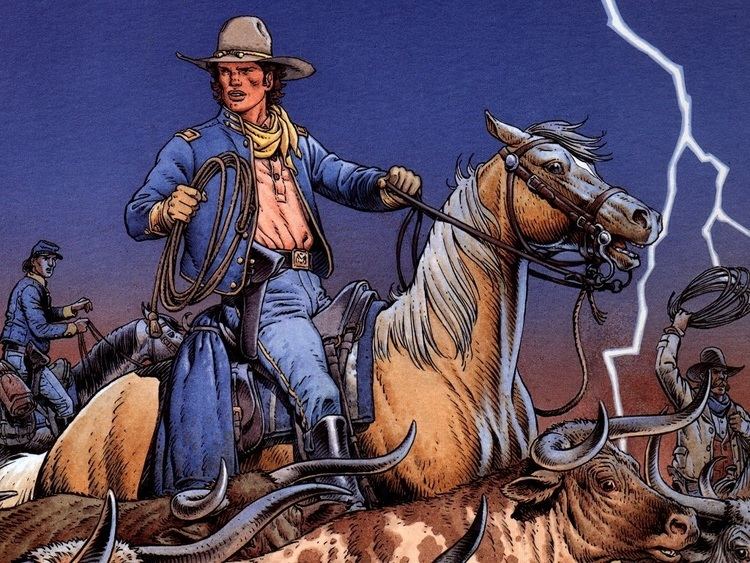
The series spawned out of the 1963 Fort Navajo comics series, originally intended as an ensemble narrative, but which quickly gravitated around the breakout character "Blueberry" as the main and central character after the first two stories, causing the series to continue under his name later on. The older stories, released under the Fort Navajo moniker, were ultimately reissued under the name Blueberry as well in later reprint runs. Two spin-offs series, La Jeunesse de Blueberry and Marshall Blueberry, were created pursuant the main series reaching its peak in popularity in the early 1980s.

It has been remarked that during the 1960s, Blueberry "was as much a staple in French comics as, say, The Avengers or The Flash here [in the USA]."
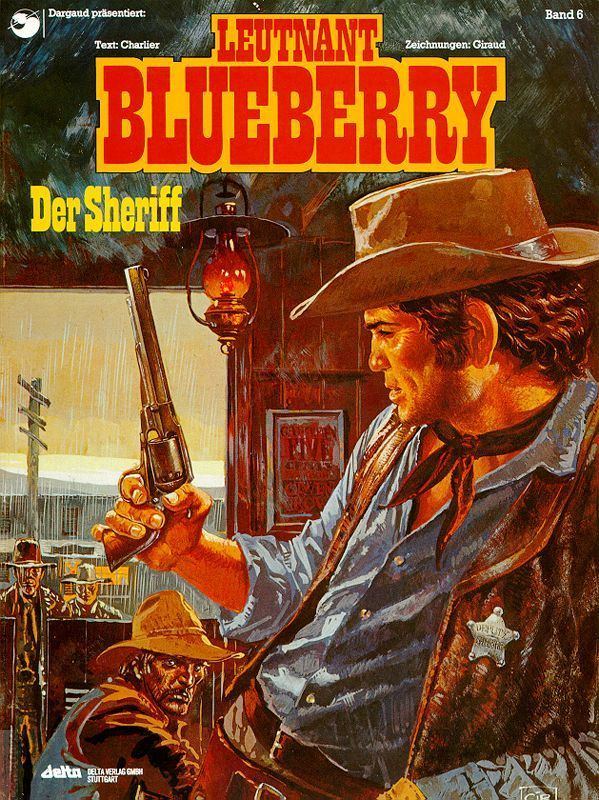
Synopsis
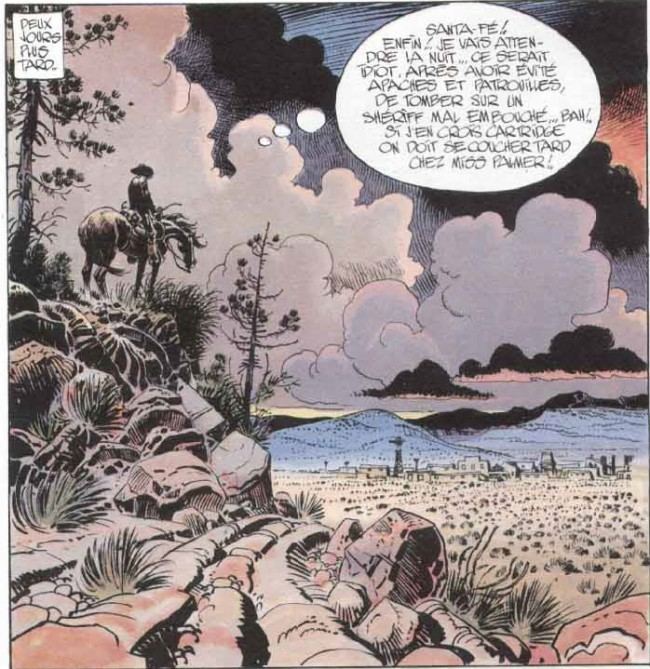
Born on 30 October 1843 on Redwood Plantation near Augusta, Georgia, Michael Steven Donovan is the son of a rich Southern planter and starts out life as a decided racist. On the brink of the American Civil War, Donovan is forced to flee north after being framed for the murder of his fiancee Harriet Tucker's father, a plantation owner. On his flight toward the Kentucky border, he is saved by Long Sam, a fugitive African-American slave from his father's estate, who paid with his life for his act of altruism. Inspired when he sees a blueberry bush, Donnovan chooses the surname "Blueberry" as an alias when rescued from his Southern pursuers by a Union cavalry patrol (during his flight war had broken out between the States). After enlisting in the Union Army, he becomes an enemy of discrimination of all kinds, fighting against the Confederates (although being a Southerner himself, first enlisting as a bugler in order to avoid having to fire upon his former countrymen), later trying to protect the rights of Native Americans. He starts his adventures in the Far West as a lieutenant in the United States Cavalry shortly after the war. On his many travels in the West, Blueberry is frequently accompanied by his trusted companions, the hard-drinking deputy Jimmy McClure, and later also by "Red Neck" Wooley, a rugged pioneer and army scout.
Original publications in French
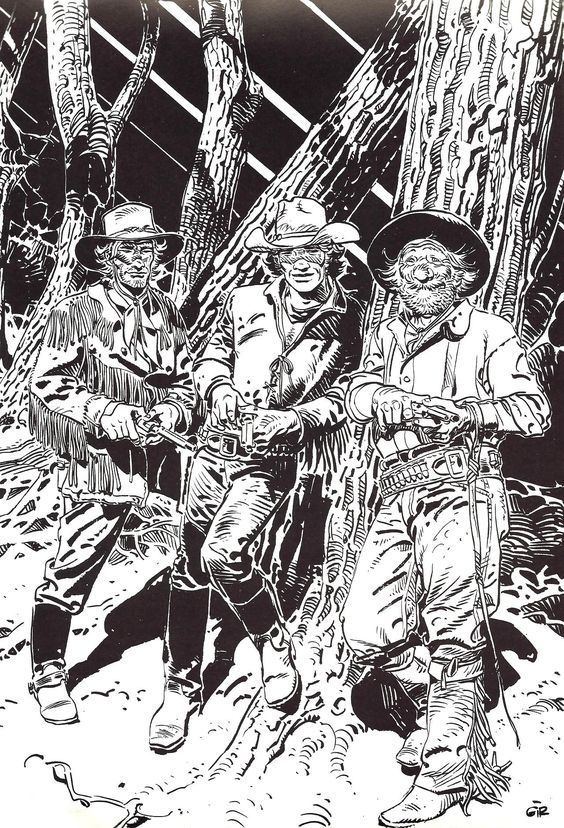
In his youth, Giraud had been a passionate fan of American Westerns and Blueberry has its roots in his earlier Western-themed works such as the Frank et Jeremie shorts, which were drawn for Far West magazine when he was only 18 – also having been his first sales as free-lancer – , the Western short stories he created for the magazines from French publisher Fleurus (his first professional tenured employment as comic artist in the period 1956-1958), and his collaboration with Jijé on an episode of the latter's Jerry Spring series in 1961, which appeared in the Belgian comics magazine Spirou (fr:La Route de Coronado, issues 1192 - 1213, 1961), aside from his Western contributions to Jijé's own short-lived comic magazine Bonux-Boy (1960/61). After his involvement with Bonus-Boy, around 1961-1962, Jean Giraud approached Jean-Michel Charlier, asking him if he was interested in writing scripts for a new western series for publication in Pilote, the by Charlier recently co-established French comic magazine. Charlier refused at first, since he never felt much empathy for the genre. In 1963 the magazine sent Charlier on a reporting assignment to Edwards Airforce Base in the Mojave Desert, California. He took the opportunity to discover the American West, returning to France with a strong urge to write a western. First he asked Jijé to draw the series, but Jijé thought there would be a conflict of interest, since he was a regular artist at Spirou, a competing comic magazine, not to mention that he was very much invested in his own Jerry Spring western, quite popular at the time. In his stead, Jijé proposed his protégé Giraud as the artist. Charlier and Giraud have also collaborated on another Western strip, Jim Cutlass.
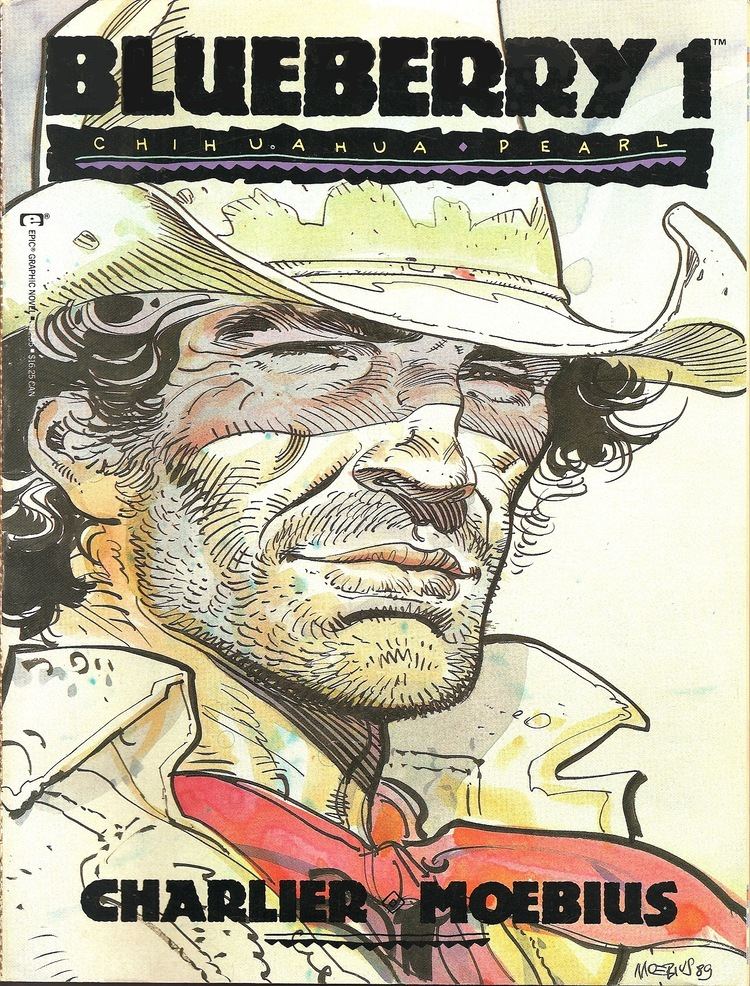
Blueberry was first published in the October 31, 1963 issue of Pilote magazine. Initially titled "Fort Navajo", the story grew into 46 pages over the following issues. In this series Blueberry - whose physical appearance was inspired by French actor Jean-Paul Belmondo - was only one of many protagonists; the series was originally intended to be an assemble narrative, but quickly gravitated towards Blueberry as the central and primary character, even though the series' (sub-)title "Fort Navajo, une Aventure du Lieutenant Blueberry" was maintained for a decade by original publisher Dargaud for the numerous reprint, and international, runs, before the "Fort Navajo" moniker was finally dropped in 1973 with the book publication of L'homme qui valait 500 000 $. Charlier came up with the name during his American trip: "When I was traveling throughout the West, I was accompanied by a fellow journalist who was just in love with blueberry jam, so much in love, in fact, that I had nicknamed him 'Blueberry'. When I began to create the new series, and everything started to fall into place, I decided to reuse my friend's nickname, because I liked it and thought it was funny. [...] I had no idea that he would prove so popular that he would eventually take over the entire series, and later we would be stuck with that silly name!"
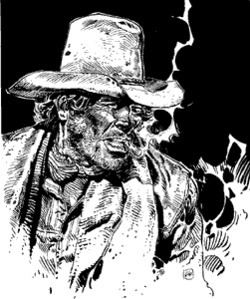
After Charlier had died in 1989, Giraud, aside from completing Arizona Love on his own, wrote and drew five albums, from Mister Blueberry to Dust, until his own death in 2012. Additionally, Giraud also scripted the intermezzo series Marshal Blueberry (1991-2000), but had no creative input for the Young Blueberry prequel series, after the first three, original volumes.
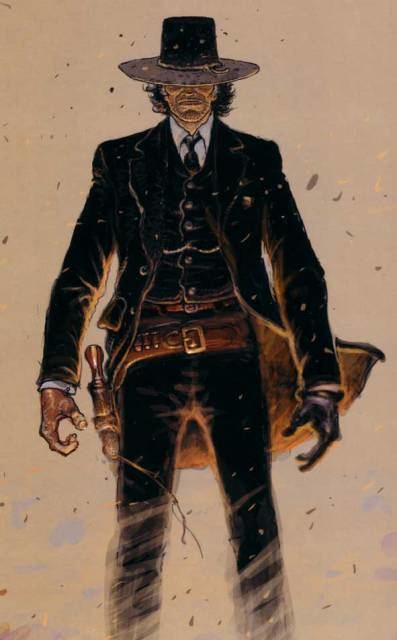
In post-war Europe, it has been tradition to release comics in "pre-publication" as serialized magazine episodes, before publication as a comic book, or rather comic album (in North-American understanding though, "graphic novel" is the more applicable terminology in this case, the distinction being a non-issue in native France), typically with a one to two year lag. In French, Blueberry has firstly seen pre-publication in Pilote and Super Pocket Pilote (1963 – 1973) from publisher Dargaud, the parent and main publisher of Blueberry, with Giraud frequently creating original Blueberry art for the magazine covers, aside from creating on occasion summarizing, introduction plates, none of which reprinted in the original book editions. After Dargaud had lost publishing rights for over a decade for new Blueberry titles, as a result from a conflict with the creators over Blueberry royalties, the series has seen French pre-publication in such magazines as Nouveau Tintin, Métal Hurlant, Super As, and Spirou, Other European countries followed the same template with local magazines. However, the format, for decades a staple in Europe and shaping entire generations of comic readers, went out of vogue in the late 1980s/early 1990s and the vast majority of European comic magazines have since then become defunct by the mid 1990s, including those from Belgium, the country were the phenomenon was born in the late 1930s. Le bout de la piste and Arizona Love, became the last serialized main series titles, though, ironically, neither were serialized in France itself, where La dernière carte had previously become the very last Blueberry title to be serialized in a magazine. Henceforth, Blueberry titles were directly released in album format, starting with the 1990 Young Blueberry title, Le raid infernal.
Royalties conflict & Blueberry's publishing wanderings
With the growing popularity of Blueberry came the increasing disenchantment over financial remunerations of the series. Already in 1974, Charlier made his displeasure known in this regard, when he had Angel Face pre-published in Nouveau Tintin of industry competitor Le Lombard, the very first time a Blueberry adventure was not serialized in Pilote – nor would it ever be in hindsight. The magazine was forced to drop the announcement page it had prepared for the story. Unfazed, Dargaud founder and owner fr:Georges Dargaud, unwilling to give in, reacted by having the book released before Nouveau Tintin had even had the chance to run the story. Then Giraud left on his own accord, to explore his "Mœbius" alter ego. While Charlier had no influence on this whatsoever, it did serve a purpose as far as he was concerned. Giraud had left Blueberry on a cliff-hanger with Angel Face, resulting in an insatiable demand for more, putting the pressure on Dargaud. Whenever Georges Dargaud asked Charlier for a next Blueberry adventure, repeatedly, Charlier was now able to respond that he was "devoid of inspiration".
Five years later, Giraud was ready to return to Blueberry. Yet, the whole business surrounding Blueberry residuals had remained unresolved, and in order to drive home the point the pe-publication of the eagerly awaited Nez Cassé story was farmed out to Métal Hurlant magazine, instead of Pilote. Yet, Georges Dargaud refused to take the bait and the creators subsequently put forward the Jim Cutlass western comic as a final effort to show George Dargaud that the creators had options. Georges Dargaud still would not budge. It was then that it became clear to Charlier, that he was left with no other option than to leave, and this he did taking all his other co-creations with him, to wit Redbeard and Tanguy et Laverdure, which, while not as popular as Blueberry, were steady money making properties for Dargaud nonetheless.
Though they were still contractually obligated to leave their most recent Blueberry title, Nez Cassé, at Dargaud for book publication, Charlier and Giraud then threw in their lot with German publisher de:Koralle-Verlag – incidentally the first German language Blueberry book publisher back in the early 1970s – , a subsidiary at the time of German media giant Axel Springer SE, for their next publication, La longue marche. The choice for the German publisher was made for their very ambitious international expansion strategy they had in place at that time. Fully subscribing to the publisher's strategy, Charlier not only revitalized his Redbeard and Tanguy et Laverdure comic series, these having become somewhat dormant in the Pilote-era because of the royalties issue, but created new ones as well, most notably the western, Les Gringos. Yet for all Charlier's business acumen, he had failed to recognize that Koralle's exuberant expansion drive had essentially been a do-or-die effort on their part. In 1978 Koralle was on the verge of bankruptcy, and a scheme was devised to stave off this fate; international expansion. In the European comics world that was a rather novel idea at the time and Koralle did expand beyond the German border into large parts of Europe with variations of their main publication Zack magazine, accompanied with comic book releases. It did not pay off however, as the holding company pulled the plug in 1982, leaving Blueberry and the others quite unexpectedly without a publishing home.
English translations
The first known English translation of Blueberry appeared 18 months after its original French magazine publication. The first outing in the series was serialized in syndication through Charlier's own EdiFrance/EdiPresse agency (the only Blueberry title known to have been disseminated in this manner outside French speaking Europe, Spain and Portugal) under its original title in the British comic magazine Valiant, starting its black and white run from July 1965 onward, though "Fort Navajo" has until 1977 remained the only translated one.
The first four English book translations of Blueberry comics were published in Europe for release in the UK in the late seventies by Danish/British joint venture Egmont/Methuen, when Egmont, holding an international license at the time, was in the process of releasing the series on a wider, international scale, for Germany and the Scandinavian countries in particular. While Egmont completed the publication of the then existing series in whole for the latter two language areas, publication of the English titles already ceased after volume 4. Parent publisher Dargaud had planned to reissue these titles and more for the North-American market in 1982/83 through their short-lived international (American) branch, but of these, only one was eventually released. That then unnoticed title, The Man with the Silver Star, has, despite the fact that Giraud's art style had by now fully blossomed into his distinctive own, not been included in later North American collections, resulting in the book becoming an expensive rarity.
Since then better marketed English translations were published by several such other companies as Epic Comics, Comcat, Mojo Press and Dark Horse Comics, resulting in all kinds of formats and quality—from b/w, American comic book sized budget collections to full color European graphic novel style albums with many extras. Since 1993 no Blueberry comics have been published in English. Moebius created new covers especially for the Epic line of Blueberry. Actually this was the first time Blueberry was published under Giraud's pseudonym, Moebius. As R.J.M. Lofficier, the translator of the books wrote: "This is quite ironic because Giraud first coined the 'Moebius' pseudonym precisely because he wanted to keep his two bodies of work separate. Yet, the artist recognizes the fact that he has now become better known in this country under his 'nom-de-plume,' and this is his way of making it official!"
The Epic publications were very shortly after their initial release collected by American specialty publisher Graphitti Designs in their "Moebius" collection, a deluxe limited edition anthology collection, released in a 1500 copies per volume edition, each volume at least containing two of the Epic releases. The collection, which ran for nine volumes, also contained Giraud's science fiction body of work, that was concurrently released by Epic in a similar manner. Volume Moebius #9, containing the "The Lost Dutchman's Mine" and "The Ghost with the Golden Bullets", also included the non-Blueberry westerns "King of the Buffalo" (short), and the other Giraud/Charlier western strip, Jim Cutlass: Mississippi River.
Non-English translations
Since its inception, the series has slowly gained a large following in Europe, and has, in part or in whole, been extensively translated in both serialized and book versions into multiple languages, to wit, Spanish (both Spain proper and the Americas), Portuguese (including Brasil), Italian, German, Dutch, Swedish, Danish, Norwegian, Polish, Finnish, Serbo-Croatian, Hungarian, Greek, Icelandic, Turkish, Tamil, Indonesian and, more recently, Japanese. In Spanish and Portuguese Blueberry has seen (licensed) publications by local publishers in the Americas, as it has in the former Yugoslavia after it disintegration into its constituent parts. In the European Union, in case of trans-border language areas, it is customary to have publishing rights reside with one publisher only.
It should be noted that the fact that Charlier had chosen to disseminate Fort Navajo outside the French, Spanish and Portuguese language areas in magazine syndication, has caused problems for publishers in other language countries, especially in Germany and north-west Europe, when Blueberry broke out in popularity in the late 1960s, early 1970s, well before the syndication term was to expire in 1974. Since Fort Navajo was the first part of a longer story line, this caused continuity, or rather chronology problems as publishers were not yet able to publish the book in their countries. The respective publishers all went about the conundrum in their own way; in Germany the book was first re-serialized as a magazine publication, before continuing with the book releases of the subsequent titles; in the Netherlands and Flanders it was decided to push ahead with book publication regardless of Fort Navajo, and in the Scandinavian countries it was decided to forego on the publication of the first five titles altogether, instead opting to start book publication with book six, L'homme à l'étoile d'argent, leaving publication of the first five titles for a future point in time. No matter what solution was chosen, it became one of the reasons for the messed up book release chronologies for those countries (only aggravated by the later addition of Young Blueberry book titles), confusing readership, especially in Germany. It was Finnish publisher Sanoma that became the first publisher able to release the first other language book edition of the title in 1974, directly after the syndication term had expired, as Navaho: Väijytys Punaisessa laaksossa (OCLC 57920924), that country's very first Blueberry book publication, thereby avoiding the conundrum. Nor had the conundrum been an issue for the UK, as book publication only started in 1977.
In the United States, California based distributor Public Square Books (currently known as Zócalo Public Square) imported Blueberry books from Spanish publisher Norma Editorial, S.A. on behalf of the Spanish speaking part of the country. Having done so in the first half of the 2000s, these books were endowed with American ISBN numbers in the form of a bar code sticker, simply put over the Spanish ISBN number. For example, Arizona Love originally carried the Spanish ISBN 8484314103, but once imported in the US, received the new, American ISBN 1594970831. Latino-Americans therefore, have been afforded the opportunity to enjoy the then entirety of the Blueberry series (including the spin-offs), contrary to their English speaking counterparts.
Apart from Europe, the Americas, Japan and Indonesia, the series has been translated on the Indian subcontinent in Mizo by Mahlua of Cydit Communications, operating out of Aizawl, and in Tamil. It is in the latter language in particular, spoken in the south-eastern part of India, Tamil Nadu, and on the island state of Sri Lanka, that the Blueberry saga has amassed a large fanbase and where he is dubbed "Captain Tiger" (கேப்டன் டைகர்). The series has been published by Prakash Publishers under their own "Lion Muthu Comics" imprint. In April 2015, an exclusive collectors edition was published in Tamil, collecting Blueberry titles 13 through 22 – with "Arizona Love" added in first time Tamil translation – in one 540-paged book. This is considered to be a milestone release in the entire Indian comics history, as well as one of the biggest collector editions of Blueberry comics worldwide, although it had already been surpassed by the time of its release by an even more massive, single book anthology of 1456 pages by parent publisher Dargaud in the original language, the year previously.
Prequel, intermezzo, and sequel
A "prequel" series, La Jeunesse de Blueberry (Young Blueberry), and the "intermezzo" series Marshal Blueberry have been published as well, with other artists and writers, most famously William Vance for the latter.
Young Blueberry (La Jeunesse de Blueberry)
A later created prequel series, dealt with Blueberry's early years, during the American Civil War, relating how the racist son of a wealthy plantation owner turned into a Yankee bugler and all the adventures after that. The material for the first three albums, conceived by the original Blueberry creators, were first seen in digest size Super Pocket Pilote during the late sixties as in total nine 16-page short stories, eight of them constituting one story-arc set in the war. The very first short story, "Thunder on the Sierra", was actually a post-war stand-alone adventure set before the events depicted in The Lost Dutchman's Mine. With the exception of the very first and very last, "Double Cross", all other shorts were originally published in black and white. Later these were blown up, rearranged, (re-)colored with some panels omitted in the process to fit the then standard album format of 46 pages (discounting the two disclaimer pages). The 1990 English language edition of these stories, by Catalan Communications under their "ComCat" line, gave track of the changes and presented the left out panels in editorials in which Giraud himself presented clarifications for the choices made. Only these first three books were published in English. The three American albums were also, unaltered and unedited, included in the aforementioned anthology collection from Graphitti Designs.
Change of artist
After Angel Face was completed in 1974, Giraud took an extended leave of absence from Blueberry, partly because he was tired of the publication pressure he was under in order to produce the series, partly because of the royalties conflict, but mostly because he wanted further explore and develop his "Moebius" alter ego, the work he produced as such being published in the by him co-founded Métal Hurlant magazine (in the US published as Heavy Metal), in the process revolutionizing the Franco-Belgian comic world. Having ended Angel Face on a cliffhanger, Giraud's return to Blueberry five years later with Broken Nose became a media event of considerable proportions and demand for Blueberry reached an all-time high. It was then that the creators decided to revisit the Young Blueberry adventures as well, which had ended its run in Super Pocket Pilote. However, Giraud was nowhere near able to take on yet another major series himself, as he was still working on his acclaimed Incal series as Moebius, besides having embarked on Blueberry again. There actually had been an additional, more prosaic reason as well for the decision to do so. After Giraud had finished Le bout de la piste he was preparing to leave for Tahiti. Having been very much invested throughout most of his adult life in New Age beliefs and practices (which included the use of mind-expanding substances), Giraud planned to join the commune of mystic Jean-Paul Appel-Guéry – in effect doing so eventually for nearly three years – , the latter had set up on Tahiti. Publisher Novedi feared, not entirely unjustified, that it endangered the publication regularity of the main series, and resurrecting, or more accurately, creating the Young Blueberry series, was the back-up strategy they had in mind. It was then that fate intervened, when Giraud, before his departure discovered the work of the still unknown ex-pat Colin Wilson from New Zealand, who was publishing a science fiction comic, Dans l'Ombre du Soleil for the French Circus comic magazine, which featured a character that shared a stunning resemblance with Blueberry. Wilson, who actually was a huge Giraud fan himself, was approached, and after a short apprenticeship to fine tune his art style (Wilson did part of the inking of Le bout de la piste, while his girlfriend fr:Janet Gale, who had followed him from New Zealand, took on the coloring, as indeed she would for all her future husband's Blueberry books), already close to that of Giraud, in order to have it move even closer to that of Giraud, embarked with fervor on the project with his first outing Missouri Demons, which essentially became the rationale for the Young Blueberry adventures to become a spin-off series onto their own.
The Young Blueberry books were until 1990 considered part of the main series by parent publisher Dargaud, the first three from the original creators in particular, before they were instituted as a separate spin-off series, mostly for the practical reason of wanting to avoid further pollution of release numbering and chronology, Wilson's Le raid infernal becoming the first released as such, as indicated on its back cover. It was not Dargaud who took the initiative for the move, but rather publisher Novedi, due to the fact that Dargaud had lost the publishing rights for new Blueberry titles, actually missing out on the first five, most successful, titles of the new series as explained. But Dargaud did adopt the format, once these rights had returned to them in late 1993. Catalan Communications had planned to publish Missouri Demons and Terror over Kansas in their "ComCat" line as well, as indicated on the back covers of the ones published, Missouri Demons actually having already received an ISBN number. Publication came to naught however, due to the demise of the publishing house in early 1991.
While several European countries (including somewhat unconventional outliers Iceland and Turkey) had, no post-original creators title has seen serialized magazine pre-publication in France/French-Belgium itself, where the titles were instead directly released as books. By the time the 1990 Le raid infernal was released however, virtually every other country had followed suit due to the demise of the serialized magazine format.
Jean-Michel Charlier and Colin Wilson
Change of writer
François Corteggiani and Colin Wilson
Second change of artist
François Corteggiani and Michel Blanc-Dumont
No UK editions have seen the day of light as of 2016, but, like the source series, the Young Blueberry spin-off series did see translations in numerous languages, the three titles by the original creators and the Wilson outings specifically, but appreciatively less so for the subsequent releases. The latter is amply exemplified by the Corteggiani/Blanc-Dumont versions, which are not that favorably received – unlike the Wilson versions, whose first three outings were notably well received, in no small part due to the fact that they were still being written by co-creator Charlier – as indicated by its diminishing popularity; had volume 12 still seen a first-print run of 100.000 copies in France in 2001, by 2015 that number had dwindled to 40.000 (which in France is near the cut-off point for a standard comic book being economically viable to become published) when volume 21 was released, aside from the fact that several publishers had foregone the publication of these book titles in their countries altogether. Currently, the spin-off series by Corteggiani and Blanc-Dumont only remains translated in Spanish, German, Dutch and Italian, a far cry from the nearly two dozen languages the main series had once been published in.
Marshal Blueberry
This spin-off series was the second attempt to further capitalize on the huge popularity the main Blueberry series enjoyed at the time. Written by co-creator Giraud, the series was set around the events depicted in The Lost Dutchman's Mine and dealt with scrupulous gun runners arming Apaches, thereby instigating an uprising. Chosen for the art work was William Vance, an accomplished Belgian comic artist in his own right and renowned for his XIII comic series. Vance drew the first two outings in the series, but declined afterwards to continue, partly because he was required to finish an album in only four months (in Europe, one year was the typical mean to complete a comic book of 48 pages, but not rarely exceeds this time span in recent decades) and that he was unaccustomed to Giraud's style as scenario writer. Additionally, even though the first book sold 100.000 copies (while respectable, relatively modest compared to the contemporary print runs of the main series, they being printed in numbers at the very least double that), fans received the book with mixed feelings as Vance's style was a too radical departure to their tastes from that of Giraud. This actually was part of the reasons why Wilson's work was so favorably received and partly the reason why Blanc-Dumont's was not. The unresolved story cycle lingered in limbo for seven years, before fr:Michel Rouge – whose style was closer to that of Giraud – was found willing to finish the cycle.
That Rouge's style resembled that of Giraud, was hardly a surprise, as Rouge was actually not a stranger to Blueberry. Twenty years earlier, when Rouge was still a quite unknown and aspiring comic artist, Giraud took him on as an apprentice and had him ink pages 15–35 of La longue marche in 1980 – thereby doing for an aspiring artist what Jijé had done for him nearly two decades before that. At the time it gave rise to the rumor that Giraud was planning to abandon his co-creation and that Rouge was groomed to take over the series. Though a rumor, there was a nuanced morsel of truth in it, as Rouge clarified two decades later, "No, he did not want to abandon Blueberry, but rather sought support and perhaps the opportunity to create books, like the ones he is currently doing [Mister Blueberry]. At the time, he was already playing with the notion of doing parallel series."
Originally intended to become a full-fledged series, the three Marshal Blueberry titles have remained the only outings in the series, though they too have seen several foreign language publications. Although not in France itself, several European countries have seen serialized magazine pre-publication of the first two titles. The third 2000 title though, was invariably directly released in book format for virtually all countries. No English language editions were released. Incidentally, in 2013 Giraud returned the favor Vance had provided for his co-creation, when he took on the art work of volume 17 for his XIII series, and which has seen English translations.
Jean Giraud and William Vance, page layout by René Follet
Jean Giraud and Michel Rouge
Blueberry 1900
A third spin-off series, tentatively coined Blueberry 1900, was conceived by original creator Giraud in the mid-1990s, intended as a bonafide sequel series. Set, as the series title already implied, in the era of the William McKinley presidency, it would not only have featured a 57-year old Blueberry, but his adult son as well, albeit in a minor role. The story line, intended to encompass five books, was to take place around events surrounding the assassination of President McKinley. Pegged for the artwork was French comic artist François Boucq whom Giraud had met at a comic event, and concurrently discussed the project with. Boucq showed interest and was enthusiastic about the project, and indeed embarked on the production of pre-publication studies, but deemed a cycle of five books too much, managing to negotiate it down to a cycle of three books.
However, Philippe Charlier, son of the late Jean-Michel Charlier and proprietor of "Editions JMC" – a foundation set up with the specific intent to safeguard the creative integrity and legacy of his father, both in a spiritual as well as a commercial sense – , was nowhere near as enthusiastic as Boucq was. He became increasingly alarmed and downright aghast when reading commentaries, Giraud made in contemporary magazine interviews, clarifying his intentions and premises for the proposed series of a Blueberry residing with the Hopi tribe, meditating under the influence of mind-expanding substances, while President McKinley was levitating in the White House due to a Hopi spell. As heir and steward of his father's co-creations and legacy, being the 50% co-owner of Blueberry, he still had the unequivocal right to veto any and all proposals regarding Blueberry and did not hesitate for a moment to exercise his prerogative in this case, going as far as taking Giraud to court, resulting in that the project fell through. As per a horrified Charlier Jr. in a later statement, "The scenario is unbelievably horrifying. It is an effrontery, constructed out of implausible circumstances. Like in the new [Mister Blueberry] story cycle, we find a totally passive Blueberry, only meditating, while the president, enchanted by Indians, is levitating in the White House". As he indicated, though he had given his seal of approval in this case, Charlier Jr., also became wary and disapproving of Giraud depicting the former lieutenant as a passive loafer in the Mister Blueberry story cycle, only aggravated from his point of view by the fact that Giraud could not refrain himself from including some elements from Native-American mysticism in OK Corral and Dust – though not anywhere near as extensive as he had intended for Blueberry 1900.
Philippe Charlier, conservative by nature like his father, had, unlike his father, no patience whatsoever with Giraud's "New Age" predilections, particularly for his admitted fondness for mind-expanding substances, subsequently vetoing his proposals for a "Fort Mescalero" one-shot, which was to feature extensive substance-induced hallucinatory scenes, besides Giraud's intention to have the Jim Cutlass series merge with the Blueberry main series, due to the fact that later volumes of that series also increasingly incorporated likewise scenes. How far Giraud actually already was in his thinking was exemplified by the inclusion of his art featuring Blueberry with Hopi tribesmen, endowed with the caption "In Hopi Towns", as the interior flyleaf illustration for the regular 1990 Arizona Love French book release, reprinted as such, without the caption, in the last 1991 Graphitti Designs release, Moebius #9.
Boucq was disappointed with the project falling through, but for him it turned out to be a blessing in disguise as it became an inspiration for Alejandro Jodorowsky (co-creator of Giraud's acclaimed Incal series, and already a frequent Boucq collaborator), to co-create with him their own acclaimed western comic. fr:Bouncer. And even the fictional "Fort Mescalero" has resurfaced as Blueberry's very first Far West posting in the 2007 prequel book Apaches. As a warming-up for Blueberry 1900, Boucq and Giraud had already collaborated on a Native-American themed project when they both contributed to the 1995 "Laissé Pour Mort", a to 500 pieces limited CD/Portfolio release from Parisian-based publisher Stardom, Giraud's own publishing house/art gallery, ran at the time by his second wife Isabelle. Later, in 2008, Giraud submitted a "Blueberry-meets-Bouncer" contribution to the to 250 pieces limited "Bouncer" portfolio from short-lived publisher Osidarta, aside from providing a foreword.
The Blueberry biography
In 1974 Charlier had a sixteen-page background article added to Ballade pour un cercueil (OCLC 893750651), when the book was first released. The article concerned a fictitious biography of Mike Steve Donovan, alias Mike S. Blueberry, detailing his life from birth to death, and written from a historic, journalistic point of view. When asked about it a decade later, Charlier clarified that once it became clear to him that Blueberry had become the central character of the series he had conceived, he then already postulated in his mind the broad strokes of the complete life and works of his creation, including the reasons for Blueberry's broken nose and odd alias. By the time Ballade pour un cercueil was ready for its book release, Charlier deemed the moment had arrived to entrust his musings to paper. There had been a practical reason as well for this. The story already ran 16 pages over-length and as contemporary printers printed eight double-sided comic book pages on one sheet of print paper, the addition of the 16-page biography was not that much of a bother for their production process. Ballade pour un cercueil therefore became one of the first Franco-Belgium comic albums to break the mold of the hitherto standard 48-page count format.
Currently somewhat of a staple in European comics, at that time the inclusion of an informative background section in a comic book of that size and wealth of detail was hitherto unheard of and a complete novelty, and what Charlier had not foreseen was that many in the pre-internet era mistook the biography for real, factual history, propagating it as such in other outside media as well. Charlier, who also was an investigative journalist and a documentary maker with a solid reputation for thorough documentation, had previously already written several, shorter historical Old West background editorials for Super Pocket Pilote as companion pieces for the Young Blueberry shorts, which were historically accurate, and readers therefore assumed that the biography was likewise.
Still, having written the biography within the historical context as postulated in the comic, fully expecting his readership to understand it as such, Charlier has never had the intention to perform a prank at the expense of his readers. "I have written a fictitious biography on Blueberry, accompanied by photographs found in American archives, and the whole world went for it!", declared a somewhat baffled Charlier, having already stated on a previous occasion, "To this very day, because of Ballade pour un cercueil in which we gave Blueberry a with photographs illuminated biography, I still receive letters from readers – not from kids mind you, but from grownups – asking how on Earth we have managed to track down the real Blueberry. There are people who take it for real fact." The photos were indeed authentic, though their captions were not. To complete the appearance of a bonafide in-universe biography, a Civil War-era style group portrait, featuring Blueberry, was included, ostentatiously recently discovered and from the hand of American artist Peter Glay, but in reality created by Pierre Tabary, a French book illustrator of some renown at the time. Incidentally, a salient detail was that events, as related in the biography, in Blueberry's life directly upon war's end, but before he arrived in the Far West, eventually became those of Jim Cutlass, the other Giraud/Charlier western.
J.M. Lofficier has translated the biography in English, specifically for inclusion in the Graphitti Designs anthology collection, published in the fourth volume of the collection, Moebius #4. Lofficier however, took it upon himself to slightly edit Charlier's original text in order to reflect Blueberry's life as featured in the post-1974 publications (despite being reprinted numerous times, not only in French but in other languages as well, Charlier himself has never revisited his original text again), and as such it is not an entirely faithful translation as some elements were added, whereas some others were omitted, such as the aforementioned notion of Blueberry ultimately heading a unit of Apache scouts.
Awards
The series has received wide recognition in the comics community, and the chief factor for Giraud receiving his first recorded international award in 1973. Listed are only those rewards, the author(s) received specifically for Blueberry, as Giraud in particular received an additional multitude of awards and nominations for his work as "Mœbius" from 1977 onward, including awards encompassing his entire body of works.
Adaptations
A 2004 film adaptation, Blueberry(U.S. release title is Renegade), was directed by Jan Kounen and starred Vincent Cassel in the lead role, with Giraud himself making a walk-on cameo appearance in the movie. Many purists were appalled by this film.
